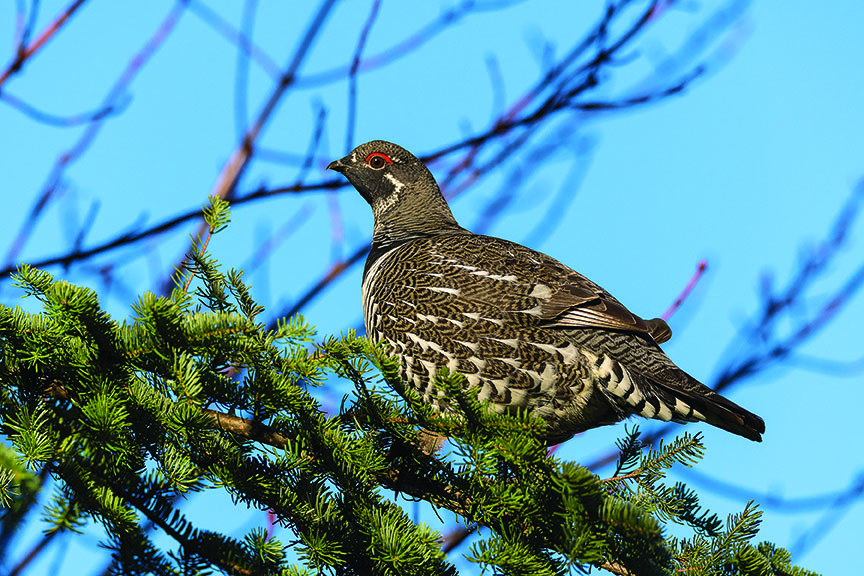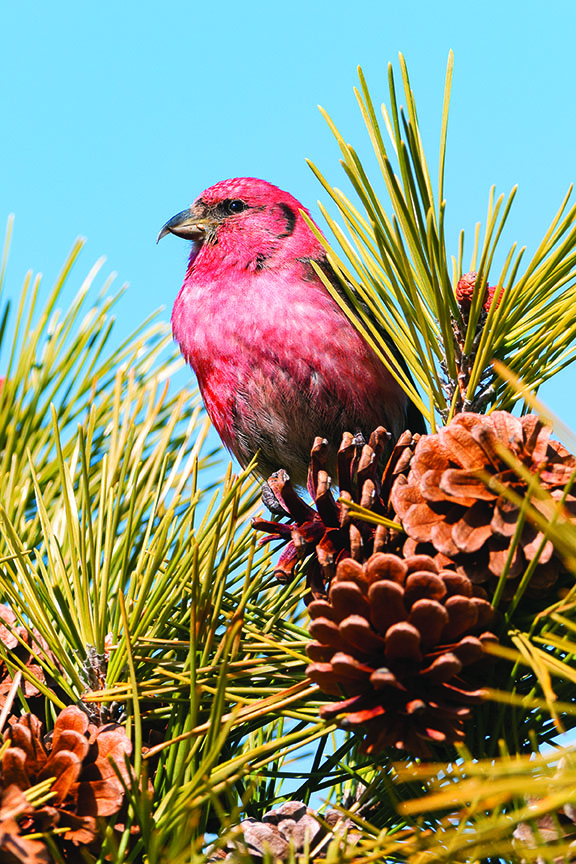The Maine Highlands Birding Trail
1. Fields Pond Audubon Center
Fields Pond Audubon Center is open to visitors from dawn to dusk. The center includes 192 acres of fields, wetlands, forest, lake shore frontage, and a 22-acre island. Bluebird boxes ring the fields where Bobolinks and Savannah Sparrows can also be found. The shrubs and woodlands produce sightings of most common songbirds, while Sora, Virginia Rail, and American Bittern calls can be heard from the marsh. The nearby Sedgeunkedunk Stream Marsh is one of the best places in the area for early spring waterfowl, many of which remain to nest. Continue along Fields Pond Road to reach the marsh.
Directions:
From I-95, take exit 45 to I-395 towards Brewer. Proceed over the Penobscot River, and then take the Parkway South exit from I-395. Turn left on Elm Street, which becomes Wiswell Road in about a mile. Continue on Wiswell Road to Fields Pond Road, turn right, and follow to the well-marked center on the left.
2. The Bangor City Forest and Orono Bog Boardwalk
The Bangor City Forest and Orono Bog Boardwalk are included in a 650-acre forest tract owned by the city of Bangor. It highlights 9 miles of hiking and biking trails and about 4 miles of access roads, with close and easy views of many songbirds. The boardwalk is a spectacular 4,200 foot long platform through a raised peat bog. Look for Lincoln's Sparrow and Palm Warblers amid the unusual plants that make the bog so interesting. The boardwalk is closed in winter.
Directions:
From the end of Hogan Road after the Bangor Mall, turn right onto Stillwater Avenue, and then travel about 1.3 miles to Tripp Drive. (You will see small signs for the Bangor City Forest and the Bog Boardwalk.) Park in the lot at the end of Tripp Drive
3. Newman Hill Preserve
Newman Hill Preserve is also known locally as the Taylor Bait Farm. It's shallow ponds attract waterfowl in the spring and shorebirds in the fall. The first pond is less than a mile long Taylor Road. A second pond is reached by walking past the gate that marks the end of the legal parking and past the private house on the right. Beyond it there is a third pond often worth checking. Park only where designated along the first pond and stay on marked trails. A footpath also winds over Newman Hill, which is well marked beyond the first point.
Directions:
From the Bangor Mall, go north on Stillwater Avenue to Forest Avenue. Turn left, proceed 1.4 miles, and turn right onto Taylor Road.
4. Leonard's Mill
Leonard's Mill is a living-history sawmill museum. While the museum complex is interesting to birders, the one-mile access road is particularly worthy. This lightly traveled dirt road traverses several habitats in rapid succession through the Penobscot Experimental Forest. It is warbler-rich environment in May and June, with the particular species changing as the access road passes from secondary growth, then conifers, over wetlands beneath a power line, and finally into the mature forest around the mill.
Directions:
Located on Route 178 in Bradley, halfway between Brewer and Milford. Watch for the sign. Park at either end of the access road. A large parking area is available at the mill.
5. Sunkhaze Meadows National Wildlife Refuge
Sunkhaze Meadows National Wildlife Refuge is a vast expanse of peat land, marsh, and wetland forest, though the interior is largely accessible only by canoe. It is breeding habitat for waterfowl, wading birds, and several unusual species. The Carter Meadow Road offers an excellent 2-mile loop hike to an observation platform looking the entire wet meadow. A parking area and kiosk are just north of the entrance. The Oak Point Trail is about 1.5 miles long, wet in spring, but with boardwalks to help in the most wet challenging places. The Johnson Brook Trail loops for about 3 miles through upland forest. A parking lot and map kiosk serve this trailhead. Both trails begin on the County Road. The Buzzy Brook Trail system is accessed from the Stud Mill Road close to where the power lines cross. The trail begins within the gated McLaughlin Road. Some of the best birding is done right from the County Road, which circumnavigates the refuge, and from the Stud Mill Road. The latter is a major logging truck route with substantial pockets of boreal forest over its length. It offers the best chance at northern species close to Bangor, including Boreal Chickadees, Gray Jays, Spruce Grouse, and Black-backed Woodpeckers.
Directions:
To reach the southern half of the refuge, take the County Road from U.S. 2 in the center of Milford. To reach the northern half of the refuge, follow U.S. 2 north to Costigan and turn right onto Greenfield Road. Take the first right, proceed for about 0.5 miles, and then turn left onto the Stud Mill Road. Continue on the Stud Mill Road for about two miles to the refuge boundary.
6. Borestone Mountain
Borestone Mountain is a unique Maine Audubon sanctuary that includes a popular hiking mountain with breathtaking views, three crystal clear ponds, and an Adirondack style lodge used for nature-based programs and education. A transition of bird species occurs during the ascent, with numerous Blackburian Warblers at lower elevation and the chance of Northern Goshawks higher on the mountain. Northern warblers and other songbirds are found around the visitor center on Sunrise pond, two-thirds of the way up the peak.
Directions:
Just after passing north through Monson, bear right onto the Elliotsville Road. Follow 7.5 miles to Big Wilson Stream Bridge. Turn left at intersection and follow signs another mile to Borestone parking lot.
7. Moosehead Lake
Moosehead Lake is the largest eastern lake within the boarders of one state. It is surrounded by private forestland that is accessible to the public, unless otherwise posted. This network of river trails and logging roads is in the heart of the forest transition zone, making it a good area for boreal species not easily found elsewhere. Moose are plentiful in area, often in roadways. Obey signs, respect private property, and follow the working forest rules of the road. Because the area has a long tourism tradition, it is a particularly good place to plan a birding adventure.
Directions:
Take I-95 north to Newport Exit 157. It Newport, take Route 7 to Dexter. In Dexter, take Route 23 to Guilford. In Guilford, take a left to get on Route 15 north to Greenville. From Bangor, take Broadway (Route 15) to Greenville.
8. Big Moose Mountain
Big Moose Mountain is a relatively short and steep ascent through rich birding habitat, transitioning from the Scarlet Tanagers of hardwood forest through zones of balsam fir and stunted spruces over the 90-minute climb. Blackpolls, Bay-breasted Warblers, Yellow-bellied Flycatchers, Boreal Chickadees, and Spruce Grouse are found near the summit. Bicknell's Thrush is a reclusive breeder. The mountain is part of the Little Moose Unit of Maine Public Reserve Land, where other hiking trails and campsites are available. The access road is lightly traveled and good for birding.
Directions:
Follow Route 15 3.5 miles north of Greenville Junction and turn west onto the North Road into the Little Moose Unit.
9. Lily Bay State Park
Lily Bay State Park is one of Maine's most popular camping parks. It contains a fine assortment of songbirds throughout. Pine Warblers are common in the white pines near lakeside. From Lily Bay to Kokadjo, the roadside is prone to moose sightings, particularly around dusk.
Directions:
The park is on the east side of the lake, 8.7 miles from Greenville on the Lily Bay Road.
10. Kokodjo
Kokodjo is a tiny community on First Roach Pond east of Moosehead Lake. Barn, Tree and Cliff Swallows flood the sky here, and local bird feeders attract finches. sparrows, and other seedeaters. For several miles north of Kokodjo, including small side roads and the road east to Second Roach Pond, there are extensive spruce forests very good for the boreal specialties. Listen for Cap May and Bay-breasted Warblers, Lincoln's Sparrows, and Gray Jays. Harvested areas that are regenerating with maple and bramble may contain Mourning Warblers.
Directions:
On the east side of Moosehead Lake, drive 18.5 miles north of Greenville.
11. Demonstration Forest
Demonstration Forest is a project of the Piscataquis County Soil & Water Conservation District. It is well hidden and lightly visited, making it attractive to birders. The 180-acre tract is managed to demonstrate varying forestry practices, which also encourages bird diversity. Several loop trails traverse differing habitats, though most of it is mature canopy forest. Ruffed Grouse is an irregular resident of the Shelterwood Trail.
Directions:
From I-95. take Exit 199 in Alton and follow Route 16 to Milo, turn right onto Route 11 and follow to Brownville. Turn left onto High Street and continue north past the Moses Greenleaf Monument along the Williamsburg Road. After the road turns to dirt and passes several mobile homes, the forest is 0.6 miles ahead across Penobscot Indian land, marked by a large sign. From the north in Brownville Junction, turn west onto Van Horne Road, then right onto Williamsburg Road.
12. Baxter State Park
Baxter State Park is the brightest jewel in Maine's crown, keeping 209,000 acres forever wild. it contains Mt. Katahdin, Maine's highest peak at 5,271 feet. There are 205 miles of hiking trails through every possible inland habitat. The road passing through the park is limited to 20 MPH, and birders can expect to take all day to explore. Pine Warblers are abundant at Togue Pond. Roaring Brook is noteworthy for Philadelphia Vireos and Least Flycatchers. Bar-breasted Warblers are seen regularly from Katahdin Stream to Kidney Pond and in all boreal areas. Nesowadnehunk Field Campground may produce Merlins and, for the next 4 miles, the road becomes very boreal - good for Blackpolls, Yellow-bellied Flycatchers, Boreal Chickadees, Spruce Grouse, Gray Jays, and uncommon Black-backed Woodpeckers. Bicknell's Thrush is possible at elevation, especially above Chimney Pond Campground, and American Pipits breed on the tablelands of Mt. Katahdin. Warblers and thrushes are abundant throughout the park.
South entrance: from I-95, take exit 244, turn west on Route 11/157, and follow through Millinocket along Route 157 to the park. North Entrance: from I-95, take Exit 264, turn west toward Sherman. Continue on Route 11 north through Patten, and then turn left on Route 159 toward Shin Pond. Follow to the park.
13. The North Woods
The North woods constitutes the region west of Baxter State Park and north of Moosehead Lake. It is comprised of 3,500,000 acres under multiple owners, much of it managed by North Maine Woods, Inc. Birders who venture into this region are participating in centuries-old tradition of public access on private lands and must recognize this is a working forest and respect its rules. Besides the myriad of undeveloped lakes and streams, there are many boreal areas that are home to the most desirable northern birds. The are two distinct sections. The bulk of these lands lie north of Moosehead lake. Another section between Millinocket and Greenville is managed separately and is called Jo-Mary/Katahdin Ironworks Area. It contains popular hiking trails. Maine public reserve lands, and several sporting camps owned by the Appalachian Mountain Club. There are multiple entrances to these regions where gated checkpoints collect day use fees and provide maps and information. See www.northmainewoods.org



